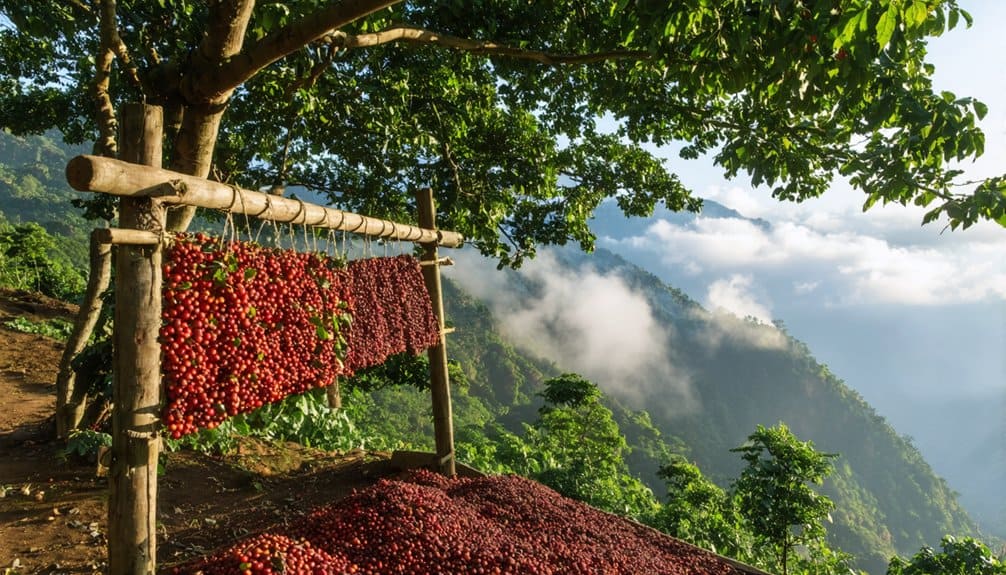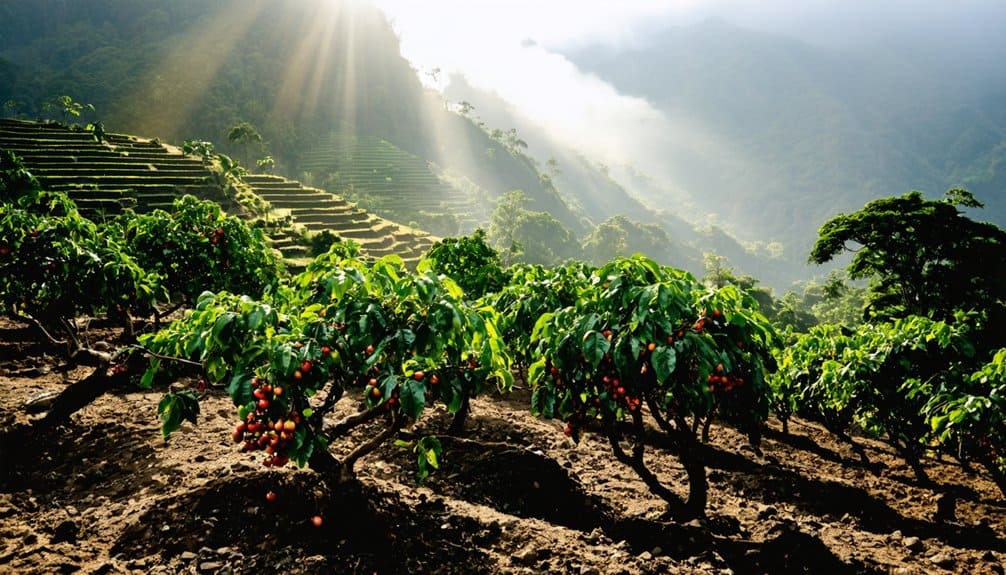You’ll find Yirgacheffe’s prized coffee farms nestled in Ethiopia’s southern highlands, where elevations of 1,700-2,200 meters create ideal growing conditions.
The region’s volcanic soils and cooler mountain temperatures slow berry development, resulting in dense beans with concentrated sugars.
Small-scale farmers cultivate these premium arabica varieties on plots averaging 1.5 hectares, producing distinctive cups with bright acidity, jasmine notes, and citrus undertones.
The region’s unique terroir holds the key to understanding these exceptional Ethiopian beans.
Key Takeaways
- Yirgacheffe’s coffee grows at elevations between 1,700-2,200 meters, creating ideal conditions for premium coffee development.
- High altitudes slow berry maturation, allowing complex flavors and concentrated sugars to develop within the beans.
- The region’s volcanic soil combines with elevation to produce distinctive jasmine, citrus, and wine-like flavor profiles.
- Small farms averaging 1.5 hectares maintain meticulous growing practices, yielding high-quality coffee cherries.
- Cool mountain temperatures and ample rainfall create perfect conditions for growing Ethiopia’s most celebrated coffee varietals.
The Geographical Sweet Spot of Yirgacheffe

While many coffee-growing regions claim ideal conditions, Yirgacheffe’s geographical coordinates create a perfect confluence of elements for exceptional coffee production.
You’ll find these prized coffee plants thriving between 1,700 and 2,200 meters above sea level, where the warm, tropical climate meets Ethiopia’s southern highlands.
The region’s volcanic soil provides crucial nutrients, while the forested hills create natural shade canopies.
You’re looking at a landscape where ample rainfall nourishes the plants, and high-altitude temperatures slow berry development.
This sweet spot in the Sidamo region delivers the precise conditions needed for complex flavor formation.
Traditional farmers enhance these natural advantages through meticulous care and harvesting, ensuring only the ripest cherries are selected.
Mountain-Grown Ethiopian Treasures
Among Ethiopia’s mountain-grown gems, the Kayon Mountain Farm stands as a premier example of the region’s coffee excellence.
You’ll find this 500-hectare estate in the Guji Zone, where the Hassen family orchestrates meticulous natural processing methods on raised beds for 12-20 days.
The farm’s volcanic soil composition contributes significantly to its distinctive flavor characteristics.
When you taste Kayon Mountain coffee, you’re experiencing the pinnacle of Ethiopian cultivation.
The cup reveals vibrant jasmine and lavender notes, complemented by citrus and stone fruit undertones.
The bright acidity and velvety mouthfeel demonstrate why this organic-certified coffee draws acclaim from connoisseurs worldwide.
At 300 tons annually, it’s making its mark on Ethiopia’s storied coffee landscape.
Altitude’s Impact on Flavor Development

Because altitude shapes every aspect of coffee bean development, understanding its impact on flavor is crucial for both producers and consumers.
You’ll find that higher elevations create denser beans with concentrated sugars, producing complex flavor profiles marked by bright acidity and pronounced sweetness.
At Yirgacheffe’s raised growing sites, you’re experiencing how cooler temperatures slow bean maturation, allowing deeper flavor development.
The result? You’ll uncover beans with wine-like acidity, fruity notes, and floral aromas.
While lower-altitude coffees offer balanced profiles, it’s the high-altitude beans that deliver the intricate layers of citrus, berries, and subtle spices that define premium Ethiopian coffee.
Terminal 3 Coffee Roasters carefully considers altitude’s role in each coffee’s unique story.
Small Farms, Big Heights: Yirgacheffe’s Growing Legacy
The distinct character of Yirgacheffe coffee emerges not just from its altitude, but from its unique farming landscape dominated by small-scale producers.
You’ll find these farms averaging just 1.5 hectares, considerably smaller than Ethiopia’s typical 3.2-hectare coffee farms.
Despite their modest size, they’re achieving yields of 1,300 kg of cherry per hectare, with farmgate prices reaching 75 Birr per kilo.
These gardens operate within sophisticated agroforestry systems, where you’ll see coffee trees thriving alongside indigenous species and other crops.
It’s this intimate scale that allows farmers to maintain the meticulous growing practices that define Yirgacheffe’s renowned quality.
The region’s nutrient-rich volcanic soil contributes significantly to the complexity of flavors found in these prized beans.
Climate and Elevation: Nature’s Perfect Balance

Perched at elevations between 1,770 and 2,200 meters above sea level, Yirgacheffe’s coffee-growing regions create an exceptional environment where climate and altitude work in perfect synergy.
You’ll find that these high altitudes slow down the coffee cherry’s maturation process, allowing beans to develop complex flavors and higher density.
The region’s volcanic soils and cooler temperatures contribute to the coffee’s distinctive profile.
The resulting beans consistently deliver jasmine and lemon flavors that have made this region’s coffee world-renowned.
- Dense, hard beans with concentrated flavors
- Natural, pesticide-free farming traditions
- Slower maturation for improved sugar development
- Best soil conditions from volcanic terrain
These elements combine to produce coffee that’s prized for its bright acidity, floral notes, and citrus undertones – characteristics that define Yirgacheffe’s unique terroir.
FAQs
How Do Local Farmers Transport Their Coffee Cherries Down Steep Mountain Slopes?
You’ll find local farmers carefully carrying coffee cherries in traditional handmade Ethiopian baskets, manually transporting their harvest down steep mountain slopes while protecting the cherries’ quality during descent.
What Traditional Ceremonies Do Yirgacheffe Farmers Perform Before the Harvest Season?
Like threads woven through time, you’ll find Ethiopia’s iconic coffee ceremony embedded in Yirgacheffe’s culture, though specific pre-harvest rituals aren’t well-documented within modern farming communities.
How Long Does It Take for Coffee Trees to Adapt to High-Altitude Conditions?
You’ll find that coffee trees typically need 2-3 growing seasons to fully adapt their root systems and metabolic processes to high-altitude conditions, developing stronger stress responses and improved flavor characteristics.
Do Wild Animals Pose Significant Threats to High-Altitude Coffee Farms?
You’ll find that most wild animals don’t greatly threaten coffee farms, and they actually benefit your operation through pollination and pest control, though occasional crop raids can require preventive measures.
What Percentage of Yirgacheffe Coffee Farmers Practice Intercropping With Other Crops?
Like a harmonious dance across the landscapes, virtually 100% of Yirgacheffe’s coffee farmers weave intercropping into their cultivation strategy, blending coffee plants with fruit trees and vegetables for ideal results.
The Bottom Line
You’ll find Yirgacheffe’s coffee farms thriving at elevations between 1,700 and 2,200 meters above sea level, where 87% of the region’s small-scale farmers cultivate their crops on plots averaging just 1.5 hectares.
These altitudes create the perfect conditions for slow-maturing cherries, resulting in the area’s signature floral notes and bright acidity.
The combination of elevation, climate, and traditional farming methods continues to position Yirgacheffe as Ethiopia’s premier coffee origin.
